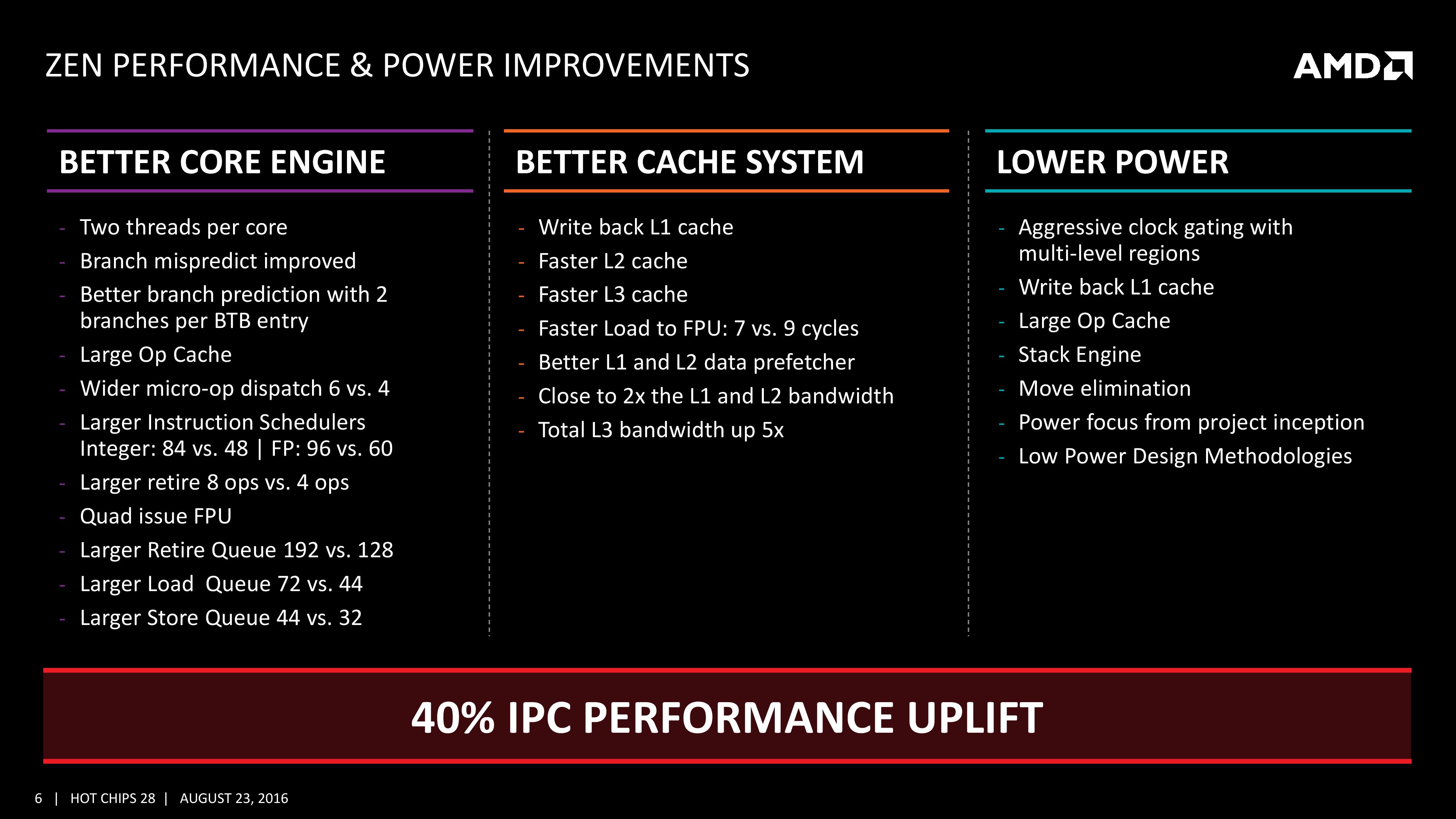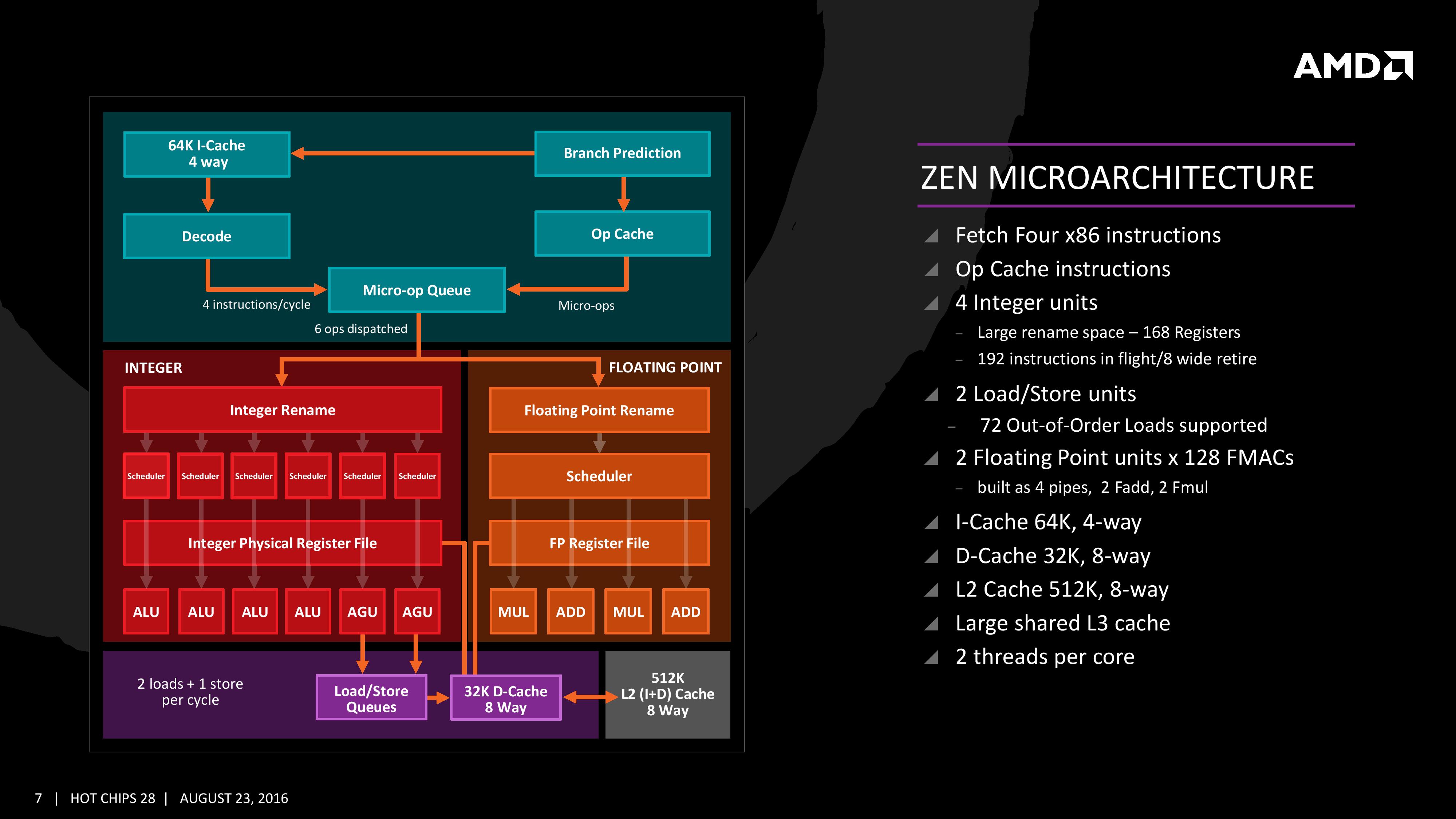AMD Zen Microarchiture Part 2: Extracting Instruction-Level Parallelism
by Ian Cutress on August 23, 2016 8:45 PM EST- Posted in
- CPUs
- AMD
- x86
- Zen
- Microarchitecture
The High-Level Zen Overview
AMD is keen to stress that the Zen project had three main goals: core, cache and power. The power aspect of the design is one that was very aggressive – not in the sense of aiming for a mobile-first design, but efficiency at the higher performance levels was key in order to be competitive again. It is worth noting that AMD did not mention ‘die size’ in any of the three main goals, which is usually a requirement as well. Arguably you can make a massive core design to run at high performance and low latency, but it comes at the expense of die size which makes the cost of such a design from a product standpoint less economical (if AMD had to rely on 500mm2 die designs in consumer at 14nm, they would be priced way too high). Nevertheless, power was the main concern rather than pure performance or function, which have been typical AMD targets in the past. The shifting of the goal posts was part of the process to creating Zen.
This slide contains a number of features we will hit on later in this piece but covers a number of main topics which come under those main three goals of core, cache and power.
For the core, having bigger and wider everything was to be expected, however maintaining a low latency can be difficult. Features such as the micro-op cache help most instruction streams improve in performance and bypass parts of potentially long-cycle repetitive operations, but also the larger dispatch, larger retire, larger schedulers and better branch prediction means that higher throughput can be maintained longer and in the fastest order possible. Add in dual threads and the applicability of keeping the functional units occupied with full queues also improves multi-threaded performance.
For the caches, having a faster prefetch and better algorithms ensures the data is ready when each of the caches when a thread needs it. Aiming for faster caches was AMD’s target, and while they are not disclosing latencies or bandwidth at this time, we are being told that L1/L2 bandwidth is doubled with L3 up to 5x.
For the power, AMD has taken what it learned with Carrizo and moved it forward. This involves more aggressive monitoring of critical paths around the core, and better control of the frequency and power in various regions of the silicon. Zen will have more clock regions (it seems various parts of the back-end and front-end can be gated as needed) with features that help improve power efficiency, such as the micro-op cache, the Stack Engine (dedicated low power address manipulation unit) and Move elimination (low-power method for register adjustment - pointers to registers are adjusted rather than going through the high-power scheduler).
The Big Core Diagram
We saw this diagram last week, but now we get updates on some of the bigger features AMD wants to promote:
The improved branch predictor allows for 2 branches per Branch Target Buffer (BTB), but in the event of tagged instructions will filter through the micro-op cache. On the other side, the decoder can dispatch 4 instructions per cycle however some of those instructions can be fused into the micro-op queue. Fused instructions still come out of the queue as two micro-ops, but take up less buffer space as a result.
As mentioned earlier, the INT and FP pipes and schedulers are separated, but the INT rename space is 168 registers wide, which feeds into 6x14 scheduling queues. The FP employs as 160 entry register file, and both the FP and INT sections feed into a 192-entry retire queue. The retire queue can operate at 8 instructions per cycle, moving up from 4/cycle in previous AMD microarchitectures.
The load/store units are improved, supporting a 72 out-of-order loads, similar to Skylake. We’ll discuss this a bit later. On the FP side there are four pipes (compared to three in previous designs) which support combined 128-bit FMAC instructions. These cannot be combined for one 256-bit AVX2, but can be scheduled for AVX2 over two instructions.












106 Comments
View All Comments
Krysto - Wednesday, August 24, 2016 - link
I think PCs in general run better on four cores than on two, even if most apps themselves can't take advantage of them, although I think in the next 5 years most new games will take advantage of 8 threads. But otherwise, it's just good for multitasking.tarqsharq - Wednesday, August 24, 2016 - link
I had an argument with one fellow on the internet regarding i7 being plenty for whatever I was doing in terms of core count. But streaming a show on one monitor while playing Overwatch was hitting 70%+ CPU usage, with all logical cores being 60-70% utilized consistently, with spikes up to 90%+.That was on my i7-4770K to be specific, running 1080P on a 144hz monitor for Overwatch, and Crunchyroll for 1080P anime stream on the second monitor.
So some games combined with slight multitasking is already taxing the 4C/8T environment.
galta - Wednesday, August 24, 2016 - link
And how much multitasking are we really using? If I had to guess, I would say not much, on average.You might have some folks here and there using it, but regular users need something between two and four cores, just as you said.
You have the OS, the software you're using, be it a game or not, plus everything that's running behind the scenes, including Windows ineficiencies, and that's it. But for some weird guy that spends his day on 7zip, more than 4 cores brings no extra power.
This is the reason why, no matter how excited we might get with 10 cores (I would love one, even if for bragging rights only), our i5s are enough for what we do.
Maybe in 5 years from now games will be multithreaded, but I'm not holding my breath: something similar was said 5 years ago, and here we are.
At the end of the day, we still need improvement in per core performance.
looncraz - Wednesday, August 24, 2016 - link
Browsers are becoming better and better at using more cores... and we're all running tens of processes in the background, some of which fire interrupts on a CPU. More cores allows for more going on at the same time without interruptions. You can actually feel this moving to an eight-core FX-8350 from a quad core i5... those eight cores provide a somewhat smoother multi-tasking environment, despite each core being slower and the overall performance being lower.Humans are simply sensitive to changes in timing - more cores and more threads reduces the variability in timing, which improves perceived performance.
galta - Thursday, August 25, 2016 - link
Hum....I don't know many people who share your opinion about FX-8350 vs i5.
Anyway, we have been multitasking for a while, a least to some extent: OS, Word, anti-virus, browser. The question is: for this light multitasking, are we better off with several cores with poor performance/core, or with less cores but with great performance/core.
Reviews and actual people generally prefer the later.
As of browsers, great news that they are improving, but download/upload speed is by far the most important factor in users experience.
Alexvrb - Sunday, August 28, 2016 - link
Download speed is fine for web browsing if you've got something faster than DSL. How much data exactly do you think you're consuming while browsing the web? Outside of streaming videos you won't use up a ton of bandwidth.Cooe - Thursday, May 6, 2021 - link
I know this is ANCIENT, but how the hell did you not realize that multi-core optimization was so bad only because nobody could afford greater than >4 core CPU's pre-Zen??? Modern games run freaking TERRIBLE now on 4c/4t i5's.Notmyusualid - Wednesday, August 24, 2016 - link
No, nope, nej, and nein.I see (FEEL) tangible improvements in my computing ever since dropped 2 cores for 4.
And it looks like others below agree....
galta - Thursday, August 25, 2016 - link
I believe you do, for the sweet spot is now around 4 cores, as I said before.The question is: do you believe that your experience will improve significantly if you mo to 6 or 8 cores?
Probably not, unless you spend your day zipping files or rendering images.
Alexvrb - Sunday, August 28, 2016 - link
They said the same thing about quad cores, and dual cores before that. AMD has to get on top of the curve, not behind it. They'll offer quad cores for more mainstream systems, and 8 for performance rigs. More for servers, and potentially less for low-power and/or low-cost.